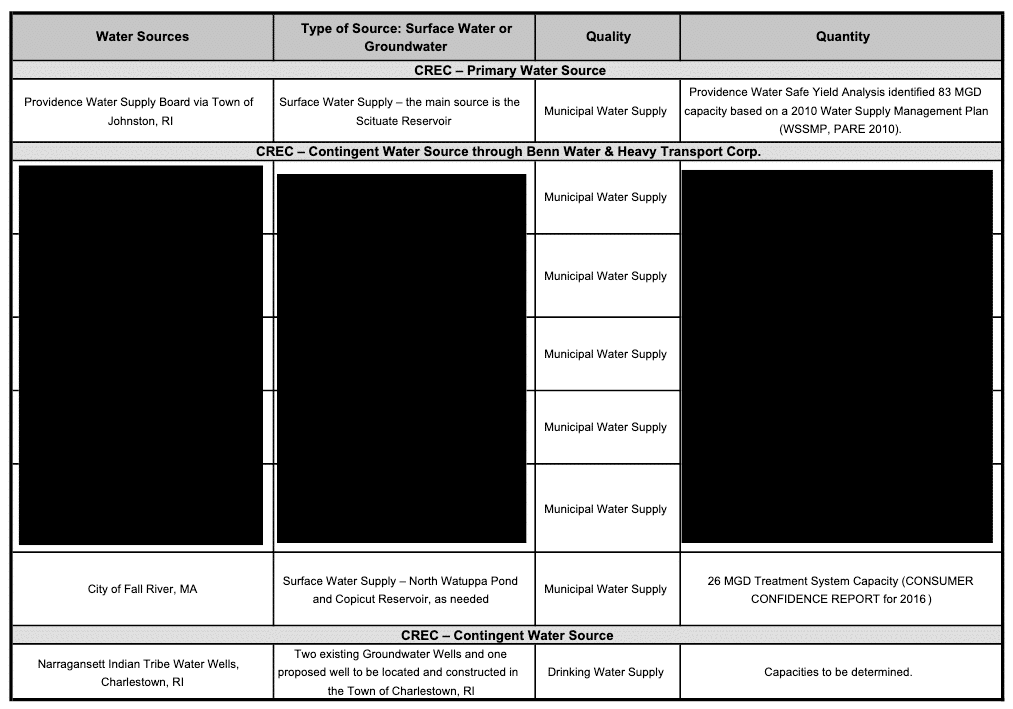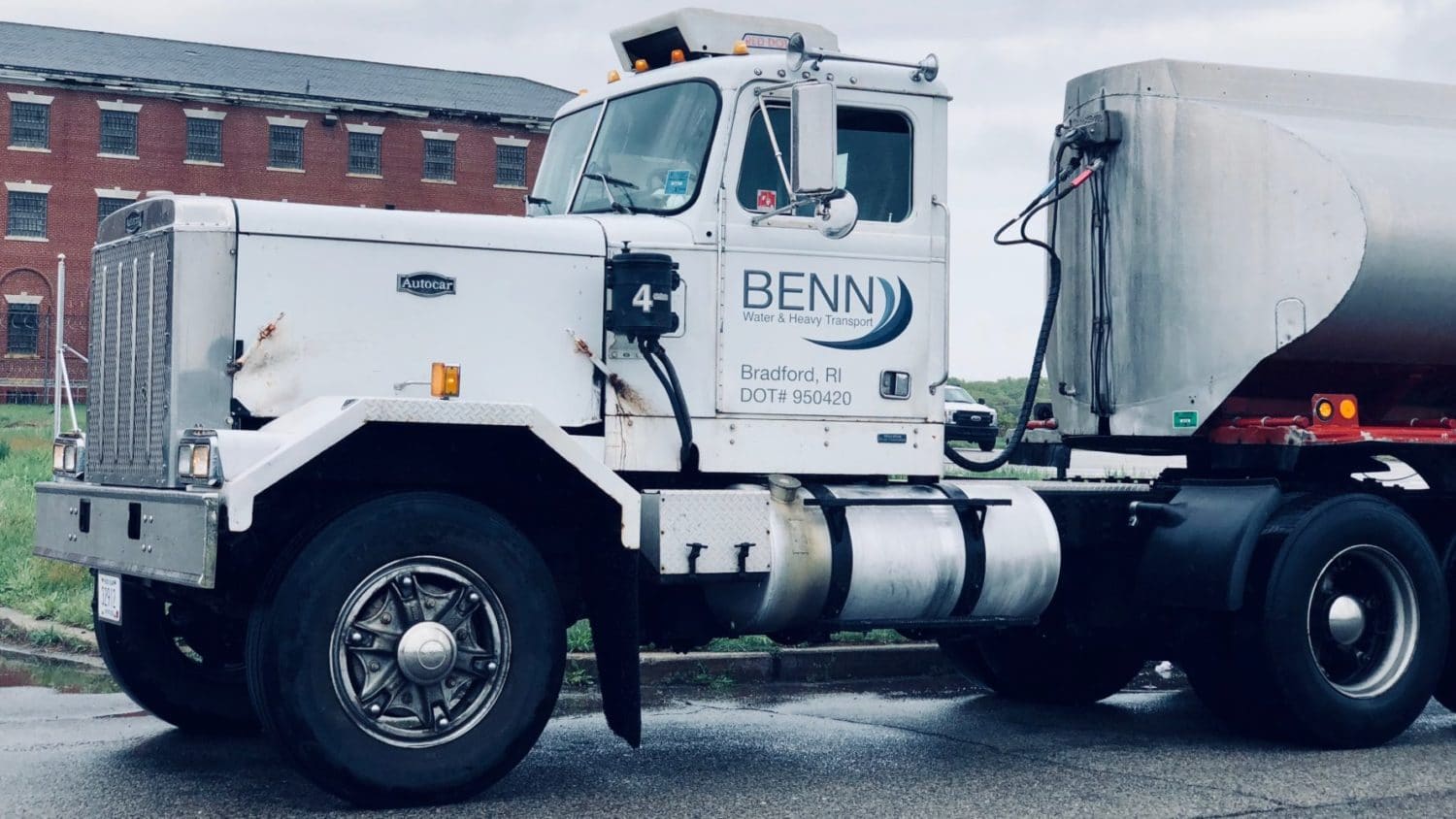Newport Water and Suez in South County may be on the hook for Invenergy’s water needs
Invenergy has identified 8 sources for the water needed to build and operate their proposed $1 billion fracked gas and diesel oil burning power plant aimed at the forests of northwest Rhode Island. (See Page 14 at this link.) Five of the sources, listed as “Municipal Water Supply” have been redacted as proprietary information. One of those sources, the Narragansett
March 5, 2019, 10:46 am
By Steve Ahlquist
Invenergy has identified 8 sources for the water needed to build and operate their proposed $1 billion fracked gas and diesel oil burning power plant aimed at the forests of northwest Rhode Island. (See Page 14 at this link.)
Five of the sources, listed as “Municipal Water Supply” have been redacted as proprietary information. One of those sources, the Narragansett Indian Tribe Water Wells, is no longer an option as Invenergy has terminated that contract.
The two sources Invenergy has identified are the “Providence Water Supply Board via Town of Johnston, RI” and the “City of Fall River, MA.” The plan for both of these water supplies is to have Benn Water and Sons, headquartered in Ashaway, Rhode Island, a private water hauler, fill up in Johnston and truck the water to Invenergy’s proposed power plant in Burrillville. Johnston is considered by Invenergy to be the primary water source. Fall River and the five unnamed municipalities are contingent water suppliers, for now.

Who are these other five water sources? This is only known to Invenergy and the lawyers debating the licensing of the power plant before Rhode Island’s Energy Facilities Siting Board (EFSB).
Why are these water sources redacted? Perhaps because when communities learn that they are on the hook for supplying water to a new fracked gas and diesel oil burning power plant, they bring political pressure to stop these deals. This has happened in Pascoag, Woonsocket, Fall River, and the Narragansett Indian Tribe.
Some interesting documentation about Benn Water has surfaced that may shine some light on this.
Benn Water fills some of its tanker trucks in Newport, paying the Newport Water Division for the privilege. In the two bills reproduced below, we see Benn Water paying Newport for 1,531, 520 gallons in August 2018 and 261,430 gallons in September 2018.


Newport Water Division supplies drinking water to Newport, 75 percent of Middletown, and a portion of Portsmouth; approximately 40,000 residents on Aquidneck Island. Newport Water also supplies water to the Naval Station and Salve Regina University where there are over 2,600 students. During droughts, Newport Water Division has required customers to reduce water consumption. These reductions routinely do not apply to resellers like Benn Water. Newport does not have an emergency water interconnection with any other municipality.
The other municipality known to be currently supplying Benn Water is Suez Water, a private company that manages and supplies the water in South Kingstown, Narragansett, Point Judith, and the University of Rhode Island (Oceanography).
Looking at documents found on pages 54-56 at this link, we see that Benn Water purchased 7,249,000 gallons from Suez in 2015; 7,189,000 gallons in 2016; and 3,522,000 gallons in 2017.
Suez Water is one of the companies that have entertained the idea of taking over the management of Providence Water under a scheme being pursued by Providence Mayor Jorge Elorza.
All of the municipalities being served by Newport Water Division and Suez have produced resolutions in opposition to Invenergy’s proposed power plant, except for Newport. Most likely, these communities have no idea that their water is a possible source of water for the building and maintenance of the proposed power plant.
The other three municipalities that currently sell to Benn Water for possible use by Invenergy are unknown, as the official record is redacted. It is as if the residents of Rhode Island have no say and no interest in how their water is to be used.
The two publicly acknowledged water sources for the Invenergy project are both in question. Fall River’s contract with Benn Water is for 6 years, and the Fall River City Council was adamant that the contract, made under somewhat suspect conditions, would not be renewed. The contract with Johnston is right now being decided by retired Superior Court Judge Michael Silverstein. If the judge decides against the deal then Newport and Suez may well be on the hook for all of Invenergy’s water consumption.
It is estimated that Invenergy will use between 15 and 60 million gallons per year.
Newport Water Division’s estimated Average Daily Demand (ADD) is 7 MGD (million gallons per day) and Maximum Daily Demand (MDD) is 12 MGD (million gallons per day). The estimated ADD for the year 2033 is 8 MGD and MDD is 14 MGD. Newport Water uses nine reservoirs on the island for water and has two drinking water treatment plants. The estimated yields of these 9 reservoirs:
1) Drought of Record = 9.398 MGD;
2) 20-Year Recurrence = 10.48 MGD;
3) Average Hydrologic Conditions = 14.6 MGD.
These numbers seem to indicate that Newport Water cannot handle Invenergy’s water consumption.
Suez Water Rhode Island ADD is approximately 3 MGD. Suez supplies water to over 19,000 residents. All the drinking water is supplied by groundwater wells. This information can be found in the water system’s Water Supply System Management Plans (WSSMPs), which are required to be written and submitted by the Rhode Island Water Resources Board.
Newport Water’s most recent WSSMP can be found here.
Suez Rhode Island’s most recent WSSMP can be found here.
Note that this report could not have happened without the work of a fabulous research team.
UpriseRI is entirely supported by donations and advertising. Every little bit helps:
Become a Patron!



